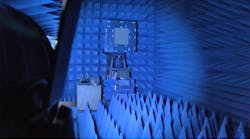Rockwell Collins recently demonstrated a directional communications link with much longer range and enhanced anti-jamming capability compared to omnidirectional communications systems. The system can also be implemented with compact, light-weight hardware for size-constrained systems, such as in satellite systems and in unmanned aerial systems (UASs).
The directional communications technology was shown to members of government research laboratories and to U.S. Department of Defense (DoD) prime contractors for possible use with their own products. Examples of the directional communications system were shown in two scenarios. In the first instance, an operator attempted to receive full-motion video but was blocked by interference, losing the communications link and the signal. The signal waveform was then reshaped by the receiver to minimize the effects of interference, allowing the receiver to regain the communications link. In the second scenario, two full-motion video links were received simultaneously from different directions to improve spectrum utilization. Different frequency bands were used in the two test scenarios (see photo).
“This is a major step in communication technology that can be applied to a variety of industries,” said John Borghese, vice president, Advanced Technology Center for Rockwell Collins. “With increased range, adaptability and jamming resistance, this new technology will enable capabilities in communications and radar previously only available on platforms with significantly higher cost and power available.”
The communication link will be ideal for use within military UAS or smaller helicopter platforms but could also be used within products for radar systems, satellite communications (satcom) systems, and commercial UAS.
The directional communications link uses technology developed under the Defense Advanced Research Projects Agency (DARPA) and the Array at Commercial Timescale (ACT) program. It can scan for signals in as many as eight different directions at one time, simultaneously receiving a variety of signals. Jamming signals can be blocked while still receiving a desired signal by changing the filtering frequencies as required.

